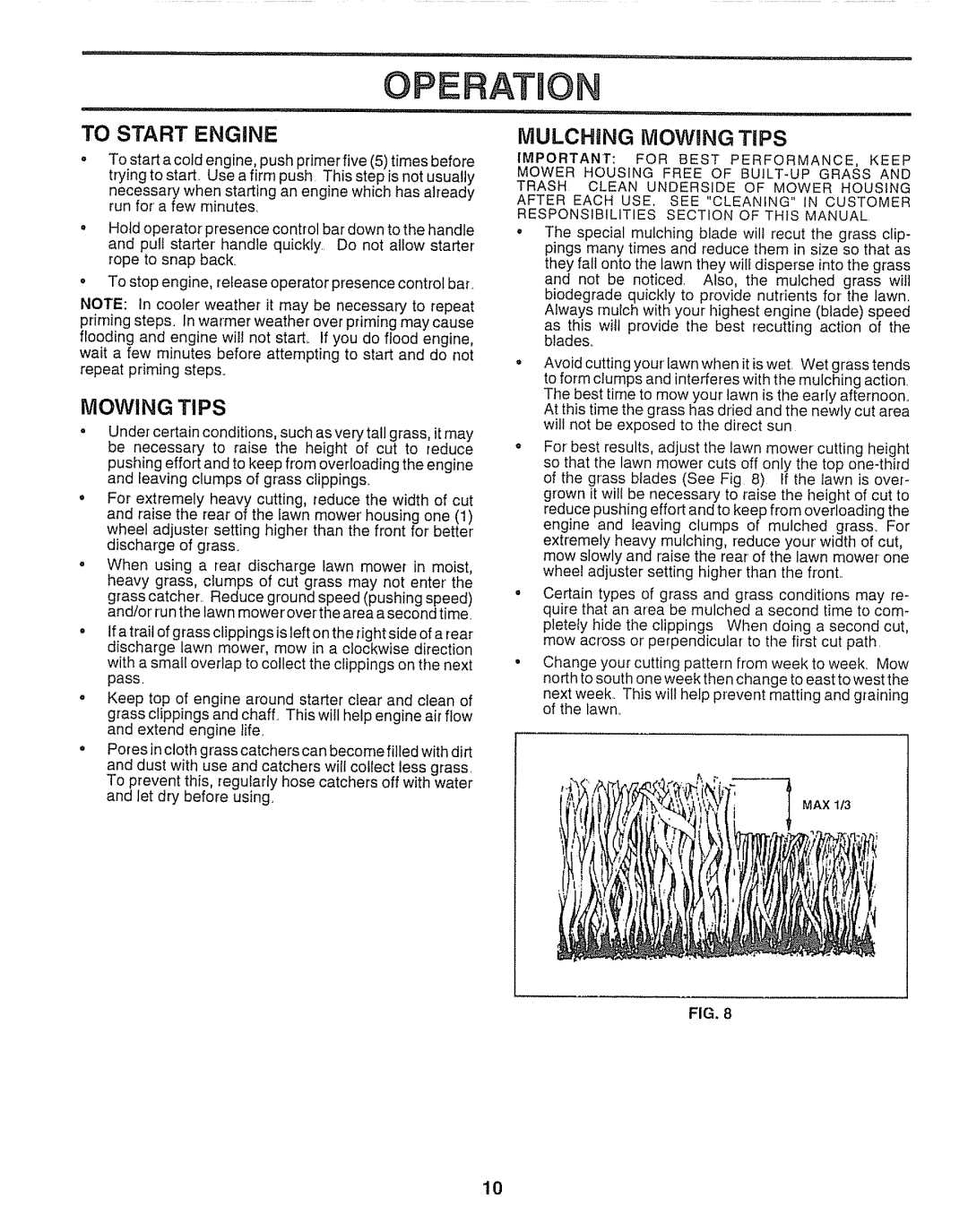
TO START ENGINE
To start a cold engine, push primer five (5) times before trying to start. Use a firm push This step is not usually
necessary when starting an engine which has already run for*a few minutes,
•Hoid operator presence control bar down to the handle and pulJ starter handle quickly. Do not allow starter rope to snap back_
•To stop engine, release operator presence control bar.
NOTE: In cooler weather it may be necessary to repeat priming steps. In warmer weather over priming may cause flooding and engine wil! not start. If you do flood engine, wait a few minutes before attempting to start and do not repeat priming steps°
MOWING TIPS
°Under certain conditions, such as very tall grass, it may be necessary to raise the height of cut to reduce pushing effort and to keep from overloading the engine and leaving clumps of grass clippings.
°For extremely heavy cutting, reduce the width of cut
and raise the rear of the lawn mower'housing one (1) wheel adjuster- setting higher than the front for better discharge of grass.
•When using a rear discharge lawn mower in moist, heavy grass, clumps of cut grass may not enter'the
grass catcher.. Reduce ground speed (pushing speed) and/or run the lawn mower over the area a second time.
°If atrail of grass clippings is left on theright side of a rear discharge lawn mower, mow in a clockwise direction
with a small overlap to collect the clippings on the next pass.
•Keep top of engine around starter clear and clean of
grass clippings and chaff. This will help engine air flow and extend engine life.
°Pores in cloth grass catchers can become filled with dirt
and dust with use and catchers will collect less grass. To prevent this, regularly hose catchers off with water and let dry before using.
MULCHBNG MOWING TiPS
IMPORTANT: FOR BEST PERFORMANCE, KEEP MOWER HOUSING FREE OF
TRASH CLEAN UNDERSIDE OF MOWER HOUSING AFTER EACH USE. SEE "CLEANING" IN CUSTOMER RESPONSIBILITIES SECTION OF THIS MANUAL
,The special mulching blade will recut the grass clip- pings many times and reduce them in size so that as they fall onto the lawn they will disperse into the grass and not be noticed. Also, the mulched grass witl biodegrade quickly to provide nutrients for*the lawn. Always mulch with your highest engine (blade) speed
as this wilt provide the best recutting action of the blades.,
°Avoid cutting your lawn when it is wet. Wet grass tends to form clumps and interferes with the mulching action. The best time to mow your lawn is the early afternoon.. At this time the grass has dried and the newly cut area will not be exposed to the direct sun
*For best results, adjust the lawn mower cutting height so that the lawn mower cuts off only the top
°Certain types of grass and grass conditions may re- quire that an area be mulched a second time to com- pletely hide the clippings When doing a second cut, mow across or perpendicular to the first cut path.
oChange your cutting pattern from week to week. Mow north to south one week then change to east to west the
next week.. This will help prevent matting and graining of the lawn..
MAX 1t3
FIG. 8
10
